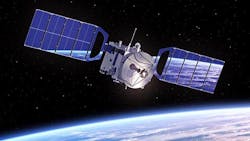White Paper Explores Crystal Oscillators for Space
Crystal oscillators (XOs) are among the many electronic components that must provide extremely high reliability for space applications. To address the requirements, Q-Tech Corp. now offers a white paper that reviews the electrical and mechanical needs of XOs for such applications as satellites and spacecraft (see the figure), including radiation hardening, small package size, and light weight. The five-page white paper, “Expanding LEO ‘Spacescape’ Impacting Oscillator Selection Criteria,” is available for free download from the company’s website.
The white paper explores what constitutes a space-qualified oscillator and the use of commercial-off-the-shelf (COTS) military-grade components for low-earth-orbit-satellite (LEOS) applications. It details different levels of radiation hardness sought for different satellite orbiting altitudes and what are the performance levels required for XOs in “space-qualified” applications. The first has developed a wide range of different-sized packaged XOs, including their innovative line of microprocessor-compensated crystal oscillators (MCXOs) with stable, radiation-tolerant outputs from 5 to 100 MHz.
“The dramatic increase in space satellites, particularly in low-earth orbit communications clusters, is providing both exceptional opportunities – and challenges – for space-qualified component suppliers,” said Scott Sentz, Q-Tech’s Director of Sales and Marketing. “Q-Tech remains at the very forefront of quartz crystal oscillator design. We are happy to offer a white paper that informs designers about the stringent performance and reliability requirements of these new space LEO applications.”
About the Author
Jack Browne
Technical Contributor
Jack Browne, Technical Contributor, has worked in technical publishing for over 30 years. He managed the content and production of three technical journals while at the American Institute of Physics, including Medical Physics and the Journal of Vacuum Science & Technology. He has been a Publisher and Editor for Penton Media, started the firm’s Wireless Symposium & Exhibition trade show in 1993, and currently serves as Technical Contributor for that company's Microwaves & RF magazine. Browne, who holds a BS in Mathematics from City College of New York and BA degrees in English and Philosophy from Fordham University, is a member of the IEEE.
